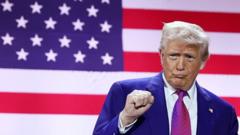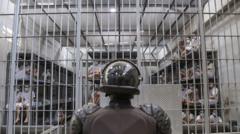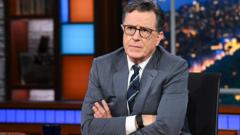Trump's claims of over $12 trillion in business investment during his presidency seem exaggerated, with experts suggesting actual commitments are significantly lower and rooted in pre-existing plans.**
Unpacking the Truth Behind Trump's Investment Claims**

Unpacking the Truth Behind Trump's Investment Claims**
A closer look at the reality of business investment trends amid Trump's assurances of record commitments.**
In recent statements, US President Donald Trump has claimed that over $12 trillion in business investments have been "practically committed" during his administration, a figure that has raised eyebrows among economists and analysts. Trump attributes this surge to his policies of tariffs, tax cuts, and deregulation, suggesting an unprecedented era of economic growth. However, the legitimacy of these claims is highly debatable.
Current economic data, which lags behind Trump's remarks, indicates that significant jumps in business investment are often linked to previous commitments made before his presidency commenced. For instance, a strong uptick in investment statistics reported from January to March 2023 is largely attributed to data distortions caused by external factors like a Boeing strike, rather than a direct outcome of Trump's economic agenda.
Economist Nick Bloom from Stanford University emphasizes the lack of robust data available to substantiate the President's assertions, stating that high levels of uncertainty may dampen business investment activity. Swiss pharmaceutical giant Roche's recent commitment of $50 billion over five years serves as a case study; while the announcement is significant, many projects were already under discussion prior to Trump's election, reflecting more continuity than change.
Moreover, Trumps’ assertion that firms such as Apple and Hyundai are significantly ramping up investments also comes with caveats. New analysis suggests that many of these commitments either existed before Trump's term or do not solely pertain to U.S. investments, leading to a figure that is far below the President’s claims. Goldman Sachs estimates new investment actually amounts to around $134 billion, and possibly as low as $30 billion after accounting for projects that might not materialize.
Political and corporate motivations for exaggerating investment figures are also noted. This trend is fueled by an environment where companies might amplify investment figures to gain favorable terms from regulatory bodies in the face of changing economic landscapes influenced by Trump's policy initiatives.
While Trump’s policies may have prompted some companies to plan for increased domestic manufacturing, particularly in pharmaceuticals, experts warn that many of these investments are structured to unfold over several years and are vulnerable to policy shifts and uncertainties regarding tariffs and pricing.
Ultimately, while Trump's strategy aims to stimulate investment, the mechanisms employed seem more reactive than proactive, often failing to address underlying issues such as industry consolidation and the nature of contemporary investments, which tend to prioritize technological upgrades over traditional manufacturing. Insights from economists suggest a broader and more sustained approach is necessary to truly invigorate the U.S. investment landscape, rather than relying solely on tariff-driven measures.






















